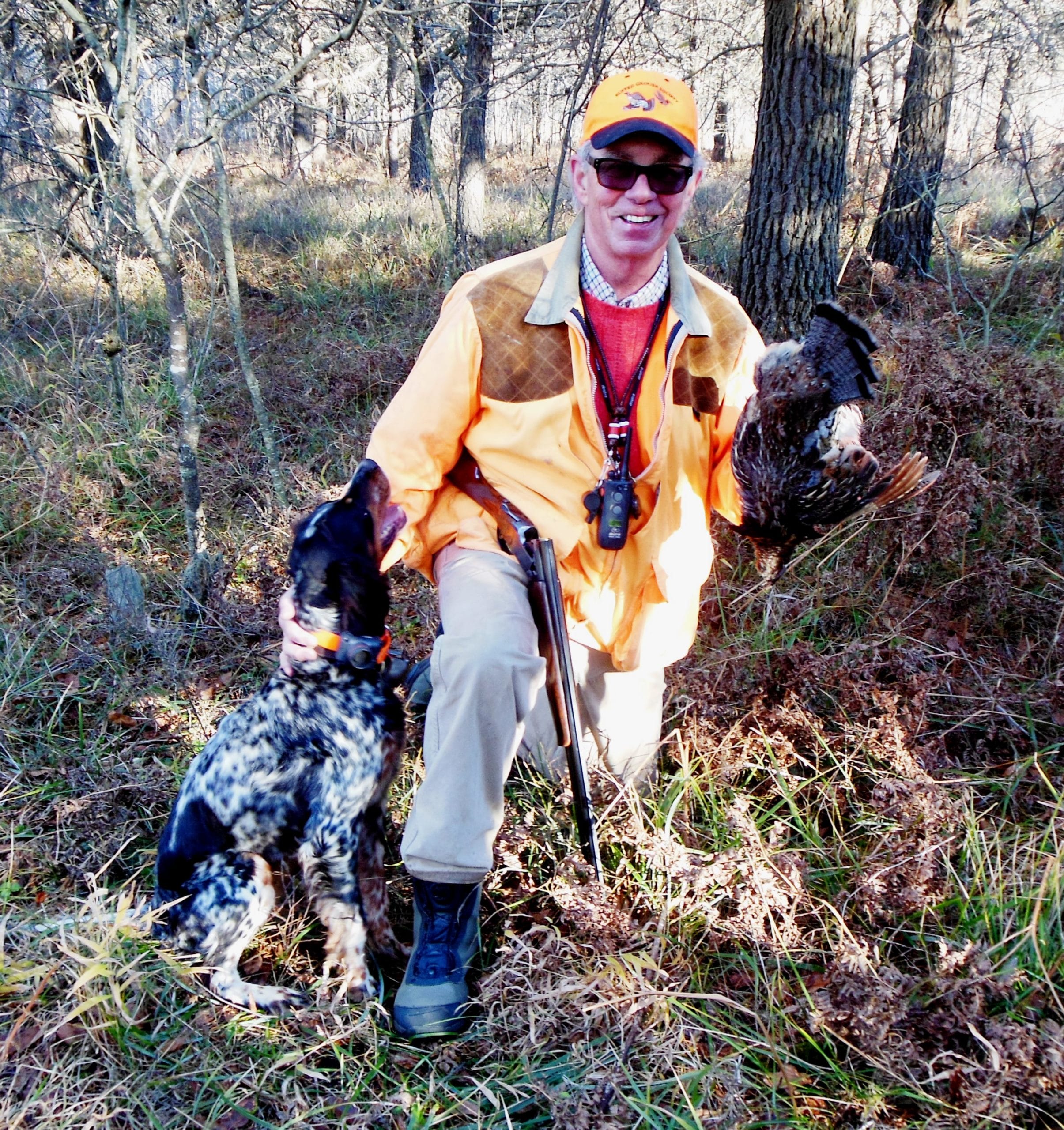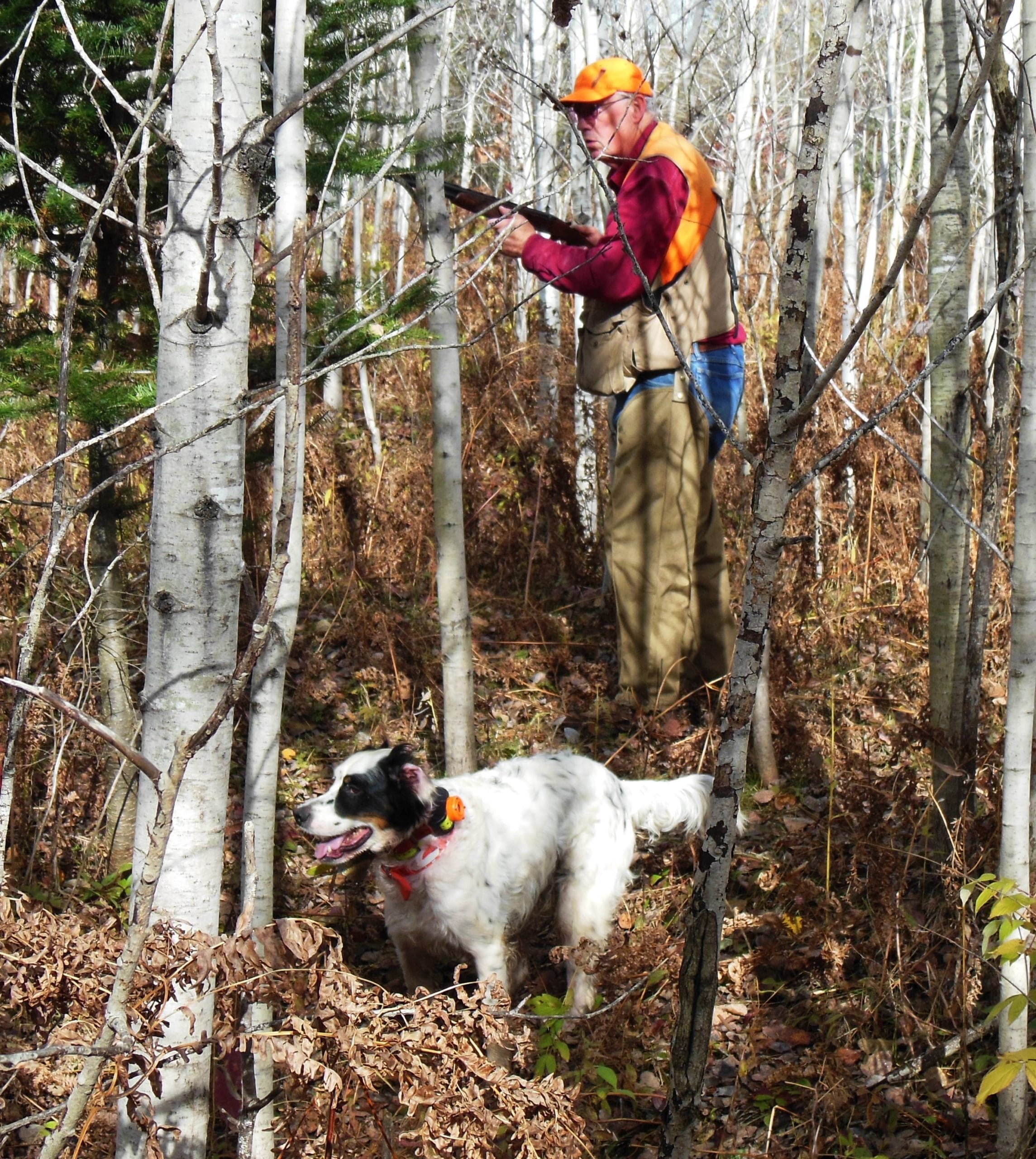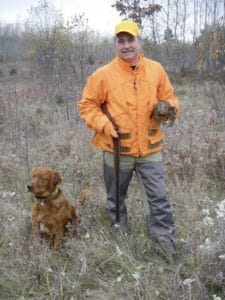by Dave Mull
Many grouse hunters who pursue this speedy quarry with dogs gauge their success by how many flushes—not kills—they get in the course of an outing. People who don’t hunt grouse may find this strange, but it’s true.

Dogs and hunters alike relish a successful grouse hunt, but success for most hunters is measured in flushes, not kills. Photo courtesy of Tom Huggler.
Lots of flushes means a grouse hunter found the right kind of area to put the dog into, that the dog found the birds, and that the hunters had enough fortitude to crawl and crash through the thick stuff to be close enough to the dog to hear and maybe even see the grouse flush.
Grouse live in places that rabbits and snowshoe hares have a hard time getting through. When the hunter with his canine goes in, harvesting a bird becomes quite an accomplishment.
Almost every year since 1986, I’ve joined a group of guys, mostly fellow writers, in the Upper Peninsula of Michigan to pursue grouse for at least four days. All 11 of us are decent shots, and a couple (not me) are close to expert shots. Several of us bring great pointing dogs or one of the flushing breeds, and the dogs all know what they’re doing. We hunt hard, we know the kinds of habitat where grouse live, and we spend several hours a day in the woods, swamps and patches of brush-filled clear cuts where large trees have been lumbered. The Michigan limit on birds in the Upper Peninsula is five, and in nearly 30 years, not one of us has ever filled it. A career day for most of us is three birds. The retired conservation officer in our group, a great shot and native Yooper, once shot four and holds the camp record.
You see, it’s not so easy to shoot a grouse.
But before we discuss the shooting aspect of the sport, let’s discuss how to find where grouse live—and perhaps gain some insight on why they aren’t easily harvested. In the Upper Midwest where I hunt, the biggest key is finding areas that have been timbered or struck by fire between five and 10 years earlier. Clearcut is a happy term in the grouse hunter’s vocabulary. Removing the big trees and their sun-blocking canopy allows smaller bushes and other flora to come back and flourish, and along with them comes the whole arboreal foodchain. Grouse are opportunistic omnivores, eating some bugs, but especially subsisting on buds, berries, grasses and leaves. Clover is a favorite of grouse. Seldom do you find much of the food grouse prefer in mature forest—grouse need new growth.

Michigan’s Al Stewart approaches a pointing setter in thick grouse cover. Successful grouse hunting often takes place in stands of young, thick aspen. Photo courtesy of Tom Huggler.
About 80 percent of our successful hunting takes place in or adjacent to stands of aspen, the individual trees about as thick as a man’s wrist and many of them growing so close it’s nearly impossible to swing your shotgun. We sometimes spy these from afar, their bright yellow leaves—or what’s left of them in the fall—giving the trees’ location away. We find vast expanses of aspens on national and state forests as well as on paper company land, which is often open to hunting. This holds true not only in Michigan, but in Minnesota and Wisconsin, too; the two other states I’ve hunted for grouse.
The best parcels of aspen have an understory of other plants, particularly bracken ferns, which help ground-walking grouse stay hidden from flying predators. When you look around and notice edibles such as wintergreen berries or small buds on trees, you’ve likely found a place with grouse. It’s time to uncase your shotgun and put your dog on the ground.
A word about dogs. The main thing a dog in the thick stuff must do to enhance and not hinder your hunt is stay close and not flush grouse where you can’t see them. That said, many pointing breeds range a bit farther, so their masters adorn them with “beeper” collars, which either beep at wide intervals while the dog is moving and looking for birds or stay silent until the dog goes on point. When pointing, the steady beep changes its sound to an electronic hawk scream, designed to get the bird to freeze in its tracks, or it starts beeping more quickly to alert the hunter that the dog might be pointing a bird.
I have always had golden retrievers, flushers, and while the aesthetic is different, they are still effective companions in the woods. They cover ground, get birds in the air and—perhaps most important—find birds that get shot. Whether hunting with a pointer or a retriever, you need to keep tabs on the dog and recognize when it is on scent so you can get ready to shoot. In the thick cover or a grouse covert, it’s best to stop walking and start “skooching” forward already in a shooting position when the dog gets “birdy” or goes on point. In other words, if you’re right handed, your left side and shoulder stays in line with where the bird is likely to get up, and you’re watching the dog with your left shoulder more or less pointed at him. You just keep sliding your left leg forward, following with your right leg.
Even when the dog doesn’t seem birdy, grouse can explode from anywhere, so it’s a good idea to constantly watch your surroundings, thinking about what small trees are in the way of your shotgun swing, safety on, of course, but always ready to shoot.
Grouse don’t need to be hit by a huge amount of lead to hit the turf, and most of my companions shoot 20 gauge, double-barrel shotguns. It’s not a snooty, status sort of thing (well, maybe it is a little). Double guns are quick to put first and second shots in the air. Some of our number use 16 gauge shooting irons; a few of us use 28 gauges. Shot size is usually 7-1/2 or 8.

Jerry Dennis, of Traverse City, Michigan, displays a grouse that was flushed and retrieved by Gabe, the author’s golden retriever.
As mentioned, we judge our success by how many birds we moved more than how many we shot. Other factors of a good day afield are common among most bird hunters include not being hoarse from yelling at the dog, not getting lost in the bush for an extended period, and not getting the truck stuck.
A school of grouse hunting that doesn’t cotton to our particular manner of hunting has practitioners that often come closer to filling the game bag. These are “road hunters” who use 4×4 trucks or ATVs. Some of these fellows call ruffed grouse “chickens.” They drive around until they spot a grouse or two along the side of the road, where the birds come to pick gravel. They stop their vehicle, get out, uncase their shotgun (some use a .22 rifle) and shoot the birds on the ground if they can.
States have different laws about how close to a roadway hunters are allowed to shoot, and from what I can tell, most road hunters ignore them—or just don’t know the rules and haven’t gotten caught yet.
One fall I found an Upper Peninsula chamber of commerce’s tabloid, a sort of annual outdoor guide, and along with stories on all manner of fishing as well as hunting for snowshoe hare, bear and deer, was a story about effective grouse hunting. The contributor had essentially written a how-to guide on road hunting. He gave lots of advice on topics such as how a 12 gauge shotgun was the most effective weapon because it put the most lead pellets in the air, and how if you left the vehicle motor running, the grouse that had ducked into the brush at side of the road was less likely to hear your footsteps. He concluded that while many bird hunters might question his techniques, he’d “rather eat them than miss them.”
In this writer’s opinion, grouse hunting done the right way involves hunters on foot and following dogs. Sure, we drive around looking at maps and finding habitat likely to hold grouse, but true blue ruffed grouse hunters don’t shoot the ones they see along the road. I don’t find legal road hunting to be reprehensible when done within the limits of the law. I just don’t think it’s as much fun as getting into the thick stuff with a close-working dog. It certainly isn’t as challenging.
I guess the bottom line is that many grouse hunters, myself included, would rather miss them than eat them.
The Union Sportsmen’s Alliance website is designed to provide valuable articles about hunting, fishing and conservation for members of AFL-CIO affiliated labor unions and all sportsmen and sportswomen who appreciate hunting and fishing and want to preserve our outdoor heritage for future generations. If you would like your own story and experience from the outdoors to be considered for our website, please email us at USAmembers@unionsportsmen.org.



